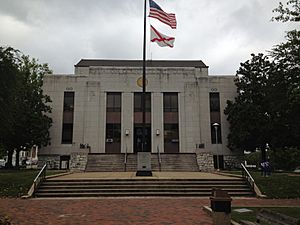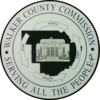Walker County, Alabama facts for kids
Quick facts for kids
Walker County
|
||
|---|---|---|

Walker County Courthouse in Jasper
|
||
|
||

Location within the U.S. state of Alabama
|
||
 Alabama's location within the U.S. |
||
| Country | ||
| State | ||
| Founded | December 26, 1823 | |
| Named for | John Williams Walker | |
| Seat | Jasper | |
| Largest city | Jasper | |
| Area | ||
| • Total | 805 sq mi (2,080 km2) | |
| • Land | 791 sq mi (2,050 km2) | |
| • Water | 14 sq mi (40 km2) 1.7% | |
| Population
(2020)
|
||
| • Total | 65,342 | |
| • Estimate
(2023)
|
64,728 |
|
| • Density | 81.17/sq mi (31.340/km2) | |
| Time zone | UTC−6 (Central) | |
| • Summer (DST) | UTC−5 (CDT) | |
| Congressional district | 4th | |
|
||
Walker County is a county in the central part of Alabama, a state in the United States. In 2020, about 65,342 people lived there. The main town and government center is Jasper. The county is named after John Williams Walker, who was the first senator from Alabama.
Walker County is also the area around Jasper that is important for jobs and community life.
Contents
History
Walker County was created on December 26, 1823. It was formed from parts of Marion and Tuscaloosa counties.
It was named after Senator John Walker, who served Alabama in the U.S. Senate from 1819 to 1822. The county became smaller on February 12, 1850, when its northern half became Winston County.
Jasper is the county seat, which means it's where the county government is located. Jasper was named after William Jasper, a hero from the American Revolutionary War who was from South Carolina.
Historic Places
Walker County has several places that are listed on the National Register of Historic Places. These are special places that are important to history and are protected. Some of them include:
- Bankhead House
- Boshell's Mill
- First United Methodist Church of Jasper
- Gilchrist House
- Jasper Downtown Historic District
- Stephenson House
- Walker County Hospital
Geography
Walker County covers about 805 square miles. Most of this area, about 791 square miles, is land, and 14 square miles is water.
The county is in a region called the Cumberland Plateau. This area has many flat-topped hills (plateaus) and valleys. There are also many forests across the county.
Neighboring Counties
Walker County shares borders with these other counties:
- Winston County (to the north)
- Cullman County (to the northeast)
- Blount County (to the east)
- Jefferson County (to the southeast)
- Tuscaloosa County (to the southwest)
- Fayette County (to the west)
- Marion County (to the northwest)
Population Facts
| Historical population | |||
|---|---|---|---|
| Census | Pop. | %± | |
| 1830 | 2,202 | — | |
| 1840 | 4,032 | 83.1% | |
| 1850 | 5,124 | 27.1% | |
| 1860 | 7,980 | 55.7% | |
| 1870 | 6,543 | −18.0% | |
| 1880 | 9,479 | 44.9% | |
| 1890 | 16,078 | 69.6% | |
| 1900 | 25,162 | 56.5% | |
| 1910 | 37,013 | 47.1% | |
| 1920 | 50,593 | 36.7% | |
| 1930 | 59,445 | 17.5% | |
| 1940 | 64,201 | 8.0% | |
| 1950 | 63,769 | −0.7% | |
| 1960 | 54,211 | −15.0% | |
| 1970 | 56,246 | 3.8% | |
| 1980 | 68,660 | 22.1% | |
| 1990 | 67,670 | −1.4% | |
| 2000 | 70,713 | 4.5% | |
| 2010 | 67,023 | −5.2% | |
| 2020 | 65,342 | −2.5% | |
| 2023 (est.) | 64,728 | −3.4% | |
| U.S. Decennial Census 1790–1960 1900–1990 1990–2000 2010–2020 |
|||
In 2020, there were 65,342 people living in Walker County. There were about 25,153 households and 17,410 families.
In 2010, the county had 67,023 people. Most people were White (91.2%), with 5.9% being Black or African American. About 2.0% of the people were Hispanic or Latino.
The average age in the county in 2010 was 41.2 years old. About 22.5% of the people were under 18 years old.
Economy
Coal mining has been a very important part of Walker County's economy for a long time. It provides many jobs for the people living there.
Transportation
Main Roads
 Interstate 22
Interstate 22 U.S. Highway 78
U.S. Highway 78 State Route 5
State Route 5 State Route 13
State Route 13 State Route 18
State Route 18 State Route 69
State Route 69 State Route 102
State Route 102 State Route 118
State Route 118 State Route 124
State Route 124 State Route 195
State Route 195 State Route 257
State Route 257 State Route 269
State Route 269
Railroads
- BNSF Railway
- Norfolk Southern Railway
Communities
Walker County has several cities, towns, and smaller communities.
Cities
- Carbon Hill
- Cordova
- Dora
- Jasper (the county seat)
- Sumiton (partly in Jefferson County)
Towns
Unincorporated Communities
These are smaller communities that are not officially cities or towns:
- Aldridge
- Argo
- Benoit
- Boldo
- Burnwell
- Coal Valley
- Corinth
- Corona
- Curry
- Dogtown
- Empire
- Goodsprings
- Gorgas (partly in Tuscaloosa County)
- Hilliard
- Lupton
- Manchester
- McCollum
- Mount Hope
- Patton
- Quinton
- Saragossa
- Slicklizzard
- Spring Hill
- Townley
- Union Chapel
Places to Visit
Walker County has some interesting places to visit, like the William B. Bankhead National Forest and Lewis Smith Lake. You can also learn about the area's history at the Alabama Mining Museum.
See also
 In Spanish: Condado de Walker (Alabama) para niños
In Spanish: Condado de Walker (Alabama) para niños


